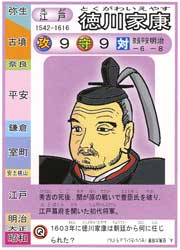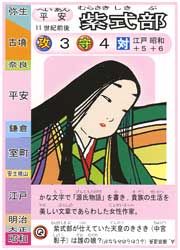Kids Web Japan
Web Japan > Kids Web Japan > What's Cool > Learning History and Geography Through Card Games
Travel
Learning History and Geography
Through Card Games

The card featuring Tokugawa Ieyasu (Shingakusha Co., Ltd.)
Two new kinds of playing cards are proving very popular with Japanese elementary school kids. They're similar to the Yu-Gi-Oh! and Pokémon game cards, but they help the kids learn about Japanese history and geography, as well as being fun.
The two sets of cards are called Historical Figures Playing Cards, which teach kids about Japanese history, and Prefecture Playing Cards, which teach them about Japan's regions. There are several ways of playing with them, one of which is a one-on-one game. For the kids, who already are experts at playing with other game cards, the game is almost second nature. The players place one card each in front of them. The card with the higher score wins, and the winner takes the loser's card. At the end of the game, victory goes to the player who has more cards. The kids engage in intense battles with their friends during morning study period or during recess.
The inventor of the playing cards is a teacher at an elementary school in Chiba Prefecture, near Tokyo. He originally made the cards as a learning tool for his class, so that the pupils could have fun while studying. The cards soon became known among teachers at other schools, and they also attracted the attention of a manufacturer of educational materials. Having been made by a schoolteacher, the information contained in the cards was accurate. And the illustrations drawn by the teacher, who once wanted to become a cartoonist, were distinctive and had a personal touch. So the cards were made into commercial products using the teacher's own hand-drawn illustrations.

The card of Murasaki Shikibu (Shingakusha Co., Ltd.)
The Historical Figures Playing Cards feature 70 famous individuals in Japanese history. Among them is Tokugawa Ieyasu, who set up the Tokugawa shogunate in Edo (present-day Tokyo) in 1603. Another is Murasaki Shikibu, the author of Genji Monogatari (The Tale of Genji), which is said to be the world's first full-length novel. Each card features an illustration of the person, basic information including the period when they lived and their accomplishments, and one study question. Numbers indicating the offensive and defensive strengths of the card are given as well.
Here's how a one-on-one game using the Historical Figures Playing Cards goes. The players start out with a quick game of "rock, paper, scissors" to decide who goes on the offensive first, and the offensive player "attacks" the defensive player. For example, if the offensive player has a Tokugawa Ieyasu card, on the card would be printed "Edo Period" (1603-1868) and "attack 9, defense 9, -6 against Nara (710-794) and Heian (794-1192), -8 against Meiji (1868-1912)." The defensive player's card - let's say Murasaki Shikibu - would have the information "Heian Period" and "attack 3, defense 4, +5 against Edo, +6 against Showa (1926-1989)." Although Tokugawa Ieyasu's offensive power is nine, six points are taken away because his opponent is from the Heian Period, bringing down his score in this match to three. Murasaki Shikibu has a defensive strength of four, but five points are added since her opponent is from the Edo Period, giving her a score of nine. So the winner is Murasaki Shikibu, and the defensive player gets to take the offensive player's Tokugawa Ieyasu card. Offense and defense are then reversed, and so the game goes on.
"Usually I don't like memorizing things, but I don't mind learning if it's to win." Many kids would surely agree. This game combining study with fun looks set to keep entertaining and educating children for some time to come.
(Updated in November 2006)